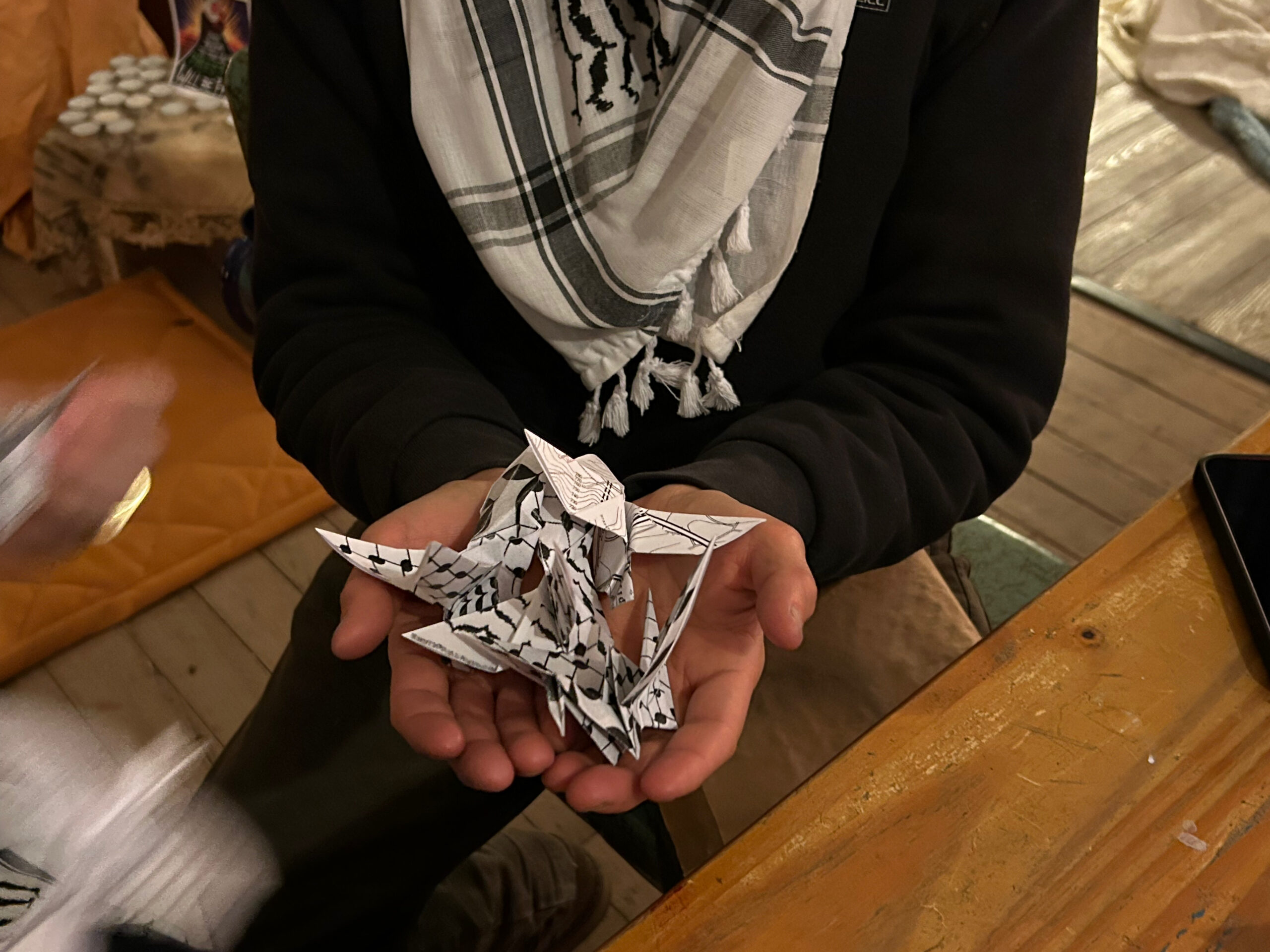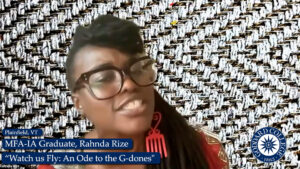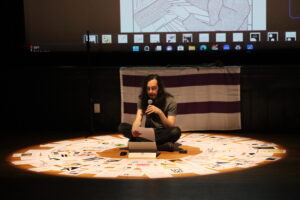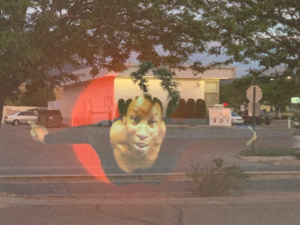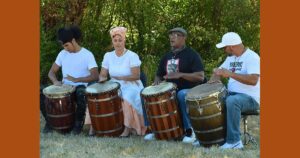Joy Cosculluela (MFAIA-WA ’14) is a performing artist, choreographer, and somatic educator and founder-artistic director of Wayfinding Performance Group, a group of multicultural women artists dedicated to excavating and reshaping personal material into the performing arts. Since graduating from Goddard College, she has continued to expand her work in decolonial practices.

Joy’s most current project, Barbette, was created at Headlands Center for the Arts, a site that Joy pointed out shares some qualities with Fort Worden. The Headlands was also originally built as a military site, then repurposed as a cultural center. Although the bunkers were dismantled in the 1940’s and the structures are in decay, the presence of the military can still be felt. Joy learned that the place was once home of Coast Miwak and began to inquire, “where are they now? What was their day to day life like? Part of decolonization is imagining the past, getting to know the people who were displaced, wondering what happened to them.” Joy found in her research that the living descendents of the Coast Miwak have built a center in Marin County. The creation stories written by their leader, “What is a Mountain Made of”, became an important part of the research for Barbette.
Collaborating with Stacy Goodman, Joy created a movement ritual around a circular structure in the battery, intending to reactivate and deactivate the military presence with the ancient power of the circle. As women or color responding to place and displacement, the performance engaged the tactic and metaphor of “cover-up”, suggesting the covering-up of self from the western gaze and the cover-up of histories. (See images) Next year they plan to bring it the work to the streets of the Bay area.
The journey of looking inward was very personal, Joy said. “I thought of it as a solo expedition, a solo quest that I needed to do. I was still raw, in search of a language to articulate the [struggle]. But I never really felt alone because [I was in it with] my advisors. How do you define alone?” She reflects that at the time, she may have felt something like aloneness,
“because the portfolio is ‘all about me, my portfolio, my work, my solo scholarship voice getting to be out there, how I define myself as an artist.’ But how do I define alone now? I’m not really alone. After my time at Goddard, my work expanded. I started looking at my identity, Indigeneity, my background of indigenous culture in the Philippines, and as a settler now. I live here in the U.S., in the bay area, where I am a settler.
Feeling alone is a very Western thing. I’m starting to dig deeper into what it means to not be alone. Who are the people who came before me, what is the history? What have I lost, in terms of not knowing? What am I learning? When I do that kind of work I feel a connection from ancestors (from Europe who intermarried from Spain and coming to the Philippines). I’m part of that bigger fabric.”

Joy’s portfolio began to engage a process of decolonization, examining and reframing her background of indigenous culture.
“This journey to undo what has been inflicted, is fraught with wounds, ‘the shadow.’ But when you look at your indigenous culture, you connect with not-aloneness. I got in touch with ancestors, researched artists, scholars not only from my own culture, but from others. I got to know specific people in the Bay area. People starting to weave decolonizing into their practices opened up new worlds for me. This shows up in my art, in my dance. My art is where my body lives.”
Collaboration is an essential part of Joy’s process, as well as intentionally prioritizing work with POC. Joy was invited to participate in the 2018 Urban X Indigenous IV festival, whose founder, Sammay Dizon, identifies herself as “an unapologetic first-generation brown femme navigating the discourse between decolonization and spirituality through art and healing practices.”
Joy spoke of the “slow process of reparations… maybe it won’t happen in our lifetimes.” However, she is encouraged by the vision and energy of young people taking up these projects of reparations, decolonization, and Indigenous resurgence. Joy began the deep inquiry into these questions of decolonization, immigrant and multicultural identities while at Goddard, documenting the deep journey in her portfolio. “I still carry connections with my Goddard advisors in my work. It was such a catalyst. I am so grateful for that time. That was just the beginning.” is a performance ritual, a somatic-expressive response to the struggle of disembodiment making way for new embodiment.
Soil is a performance ritual, a somatic-expressive response to the struggle of disembodiment making way for new embodiment.
Performers Joy Cosculluela and Tomoko Hiraoka respond to the installation art “An Aberrational Poetics: Inside Me an Island Shaped W/hole” by artists Lehua Taitano & Lisa Jarrett.
“Soil” is a collaboration by two immigrants and women of color; How we constantly redefine our connection with home and its complexities in today’s modern context, grieving, resisting, and seeking agency.

We are inspired by themes of “survivance,” a word created by Anishinaabe scholar Gerald Vizenor, which means more than survival – it is a way of life that nourishes indigenous ways of knowing. Mindful of the histories of millions original inhabitants before us, we recognize the narratives of belonging, the stories that stem from blood, sweat and tears of people known and unknown who have dedicated their lives so that we can live more freely. How do we balance, navigate past and present, re-root?
Our performance piece re-imagines and cross-pollinates the materials in the installation: the islands making their mark against a white backdrop, the plant symbolizing nourishment and resilience, the love song and eating as acts of agency and healing. We embody survivance in contemporary times by listening and responding intently, unburdening the old, planting new roots, chewing new life, and taking pride in who we are.
Through our bodies and imaginations, we persist, resist, rebound, and create a new narrative of belonging. We embrace wholeness and look forward, making ourselves visible and contributing vibrantly to our community.

Title of project: Barbette
Barbette:
def: A mound of earth or a platform in a fortification, a protective circular armor support on which guns are mounted to fire over the parapet
A multidisciplinary site-specific project
A collaboration by Bay Area artists video/visual artist Stacey Goodman and choreographer JoyCosculluela & the Wayfinding Performance Group
At Fort Barry, a former 1908 army post located in the Marin Headlands, north of SF, along the West Coast.
Performers/ collaborators: Tomoko Hiraoka and Jessica Brown.

Photos by Click Dominique

